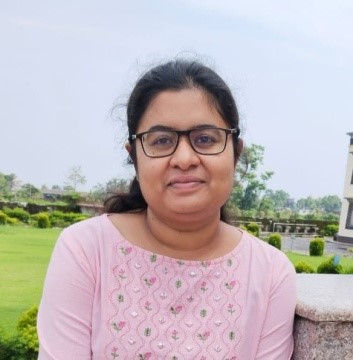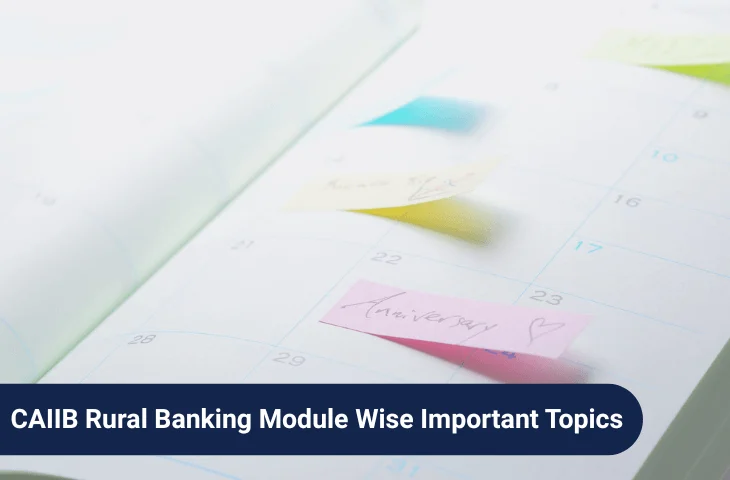The CAIIB (Certified Associate of Indian Institute of Bankers) is a prestigious professional banking exam conducted by the Indian Institute of Banking & Finance (IIBF). Among its elective papers, Rural Banking is a key focus for bankers dealing with priority sector lending, rural development, financial inclusion, and agricultural financing.
In this blog, we have provided the most important topics for the Rural Banking elective paper, module-wise weightage, and expert insights based on previous year trends and question patterns.
CAIIB Rural Banking Important Topics
The module-wise breakdown of important topics is as follows:
| Module | Important Topics |
| Module A – Rural India & Development | 1. Characteristics & Features of Rural India 2. Panchayati Raj & Self-Governance in Rural Areas 3. Rural Poverty – Measurement & Estimation Methods 4. Policies & Programs for Poverty Alleviation 5. Agriculture in Rural India – Key Features 6. Agricultural Schemes – PM-KISAN, Fasal Bima Yojana, National Mission for Sustainable Agriculture 7. Rural Development Programs – MGNREGA, National Social Assistance Program |
| Module B – Financing Rural Development | 8. Rural Development Financing Models & Trends 9. Financial Inclusion in Rural Areas 10. Role of Banks in Rural Development 11. Credit Delivery Models – Microfinance, SHG-Bank Linkage, NABARD, SIDBI 12. Technological Innovations in Rural Financing (Digital Banking, IoT, Agri-Tech Applications) 13. Risk Mitigation & Problem-Solving in Rural Lending |
| Module C – Priority Sector Lending & Government Initiatives | 14. Priority Sector Lending (PSL) – Concepts, Guidelines, and Targets 15. Non-achievement of PSL – Remedies & Bank Responsibilities 16. Financial Literacy, Financial Education & Awareness Programs 17. Education-Related Schemes & Education Loans 18. Rural Housing & Other Social Development Initiatives |
| Module D – Technological Advancements & Contemporary Trends | 19. Latest Technological Tools in Rural Banking 20. Digital Banking & Fintech for Rural Areas 21. Use of IoT, AI, and Digital Devices in Agriculture & Allied Sectors 22. Micro-Credit & Self-Help Group Financing Models 23. Role of NABARD, SIDBI, and other institutions in rural finance 24. Emerging Opportunities & Challenges in Rural Banking |
Also Check: Which Elective Paper to Choose for CAIIB
CAIIB Rural Banking Module-wise Weightage
Based on previous years’ trends and expert feedback, the estimated weightage of modules is:
| Module | Estimated Weightage (%) |
| Module A | 25–30 |
| Module B | 30–35 |
| Module C | 20–25 |
| Module D | 15–20 |
Key Observation: Modules A & B carry the highest weight, focusing on rural development, poverty, agriculture, and financial inclusion.
CAIIB Rural Banking Exam Structure
The CAIIB Rural Banking exam is conducted online by IIBF and consists of multiple-choice questions, case studies, and scenario-based questions to test both conceptual understanding and practical application.
| Feature | Details |
| Total Questions | 100 objective-type MCQs |
| Total Marks | 100 |
| Case-Based Questions | Includes case studies & passages |
| Numerical Questions | Limited, mainly from Module B |
| Exam Mode | Online (Computer-Based Test) |
| Negative Marking | No negative marking |
| Exam Language | English / Hindi |
Preparation Strategy for Rural Banking Elective
The Rural Banking paper requires a mix of theoretical knowledge and practical understanding of rural finance and development schemes.
- Focus on High-Weightage Modules: Give priority to Modules A and B covering rural India, agriculture, poverty alleviation, and rural financing models.
- Understand Government Schemes: Prepare for agricultural schemes, rural development programs, education loans, and housing schemes.
- Financial Inclusion & Literacy: Emphasize PSL guidelines, financial inclusion models, and literacy/education initiatives.
- Technological Advancements: Learn the application of digital banking, microfinance tech, IoT, and other innovations in rural finance.
- Practice Case Studies: Case-based and passage-based questions often relate to real-life applications of schemes and financial inclusion.
- Revise Regularly: Consolidate your knowledge of key policies, institutional roles, and technological applications.
FAQs
Modules A & B – Rural development, agriculture, poverty alleviation, and financing models.
Yes, especially digital banking, microfinance delivery models, IoT, and fintech applications.
Understand the background, government schemes, financial inclusion models, and apply theory to practical rural scenarios.
Limited, mainly related to credit allocation, PSL targets, and finance calculations in Module B.
Yes, questions often include updates from latest rural schemes, technological trends, and government initiatives.
- CAIIB ABM Exam Analysis 2025, All Shifts, 30th November
- Difference Between JAIIB & CAIIB, Eligibility, Exam Pattern
- CAIIB ABFM Module-Wise Preparation Tips & Tricks, Check Details
- CAIIB Risk Management Important Topics, Module-wise Weightage
- CAIIB Rural Banking Module-wise Important Topics
- CAIIB HRM Elective Paper Important Topics and Preparation Strategy

Hi, I’m Aditi. I work as a Content Writer at Oliveboard, where I have been simplifying exam-related content for the past 4 years. I create clear and easy-to-understand guides for JAIIB, CAIIB, and UGC exams. My work includes breaking down notifications, admit cards, and exam updates, as well as preparing study plans and subject-wise strategies.
My goal is to support working professionals in managing their exam preparation alongside a full-time job and to help them achieve career growth.
